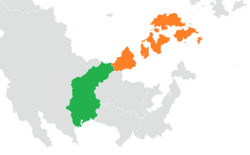Pulacan-Pulau Keramat relations
This article is incomplete because it is pending further input from participants, or it is a work-in-progress by one author. Please comment on this article's talk page to share your input, comments and questions. Note: To contribute to this article, you may need to seek help from the author(s) of this page. |
Relations between the nations of Pulacan and Pulau Keramat are often reflective of the greater Kabaya'an ideology, with the two Malaio based nations having a long history of political, social, and economic interacation with one another.
 | |
Pulacan |
Pulau Keramat |
|---|---|
| Diplomatic mission | |
| Pulatec Embassy, Kopiona Poi | Pulaui Embassy, Mabesekwa |
| Envoy | |
| Ambassador Acnel Atonemac | Ambassador Korpore Pala |
Country comparison
| Populations | 83.5 million (2022) | 46.4 million (2020) |
| Area | 594,880 km2 | 749,856 km2 |
| Population density | 140.28/km2 | 61.93/km2 |
| Capital | Kopiona Poi | Aachanecalco Mabesekwa Mohembo Yztac Tlalocan |
| Largest city | Tau Harimua | Aachanecalco |
| Government | Confederated oligarchical constitutional republic | Federal parliamentary republic with an executive presidency |
| Current Leader | Dewan Emas Council (both head of state and government) |
President Coyotl Gontebanye (head of state) General Secretary Moctezuma Tshireletso (head of government) |
| Official languages | Birha, Mataram, Raji, Tuganani, Ahlranese | Setswana, Pulatec Nahuatl |
| Main religions | N'nhivara (44%) Bulanan Asalism (20%) 'Iifae Azdarin (8%) Margaya (5%) Panonpoé Asalism (5%) Other (21%) |
Tlaloc Cozauism (73%) N'nhivara (10%) Asalism (6%) Azdarin (4%) Other (7%) |
| GDP (nominal) (2020) | $1.9 trillion ($23,951 per capita) | $1 trillion ($21,712 per capita) |
| Military expenditures |
History
Modern-day Pulacan was peopled by various Komontu peoples from the 500s CE, with many fishing communities formed on the nation's Karaihe coastline. These communities grew thanks to the abundance of both seafood and trade goods accessible from the Karaihe and Ozeros Seas. Over the next five centuries, the northern communities began to form a separate identity from the wider Komontu diaspora, acting as trade mediaries between the central Djebe highland tribes and the maritime states of Malaio. The early stages of Pulaui-Pulatec relations is exemplified in the modern city of Mabesekwa, founded as X in the late 11th century CE as a joint trade outpost by the Pulaui-based Tahamaja Empire and a league of various merchant houses from the Tyresene city-states. The city quickly blossomed into a center of multicultural exchange, seeing ideas, goods and technology move to and from inland Pulacan, the Ozerosi region, and even the faraway Periclean Sea Basin.
Kuroranu Taihu
Kuroranu Taihu is a binational planned city project along the land border between Pulacan and Pulau Keramat. Housing X people, it was founded in 1963 as a set of twin sister cities. Each nation's side of the city rests on their side of the X River's whitewater rapids system, which serves as the national boundary line in the southern Siva'Uia region. Constructed in only four years to plan, the city stands as a physical testament to the principles of Kabaya'an. Governance of the city was handled by separate local administration until 1988, when the Kuroranu Taihu Joint Memorandum of Understanding on Governance (JMUG) was signed by the Pulatec and Pulaui governments. The JMUG agreement established a joint government for the two halves of the city, as well as a network of provisions and treaties that allowed for the smooth merging of city services and amenities across the borders under the new city council. Today, the city remains one of the only urban localities in the world to officially be within two countries at once.
Initially, the collective economy of Kuroranu Taihu was supported almost solely by government subsidies, as the city gained its early prominence as a symbol of Ozerosi accomplishment and achievement. Business exchange followed the diplomatic exchange, however, and the city experienced its first real organic growth following Pulacan's accession to the Vespanian Exchange Institute in 1982, at a leadership conference hosted in the city. Kuroranu Taihu plays host to numerous diplomatic gatherings, and it remains one of the premier spots for negotiations and summits in the wider Malaio-Ozeros region. The economy is bolstered by a shared Special Economic Zone encouraging business and international financial exchange. The city's stock exchange opened in 2004, eclipsing the Tepetenxipaltlan Stock Exchange in registered trades and becoming one of the primary exchanges in the Ozeros, cementing the city's position as an "Kabaya'an project." The area around the city experiences further economic stimulation via Joint Base Kuroranu, a Pulaui-Pulatec army and air base near the outskirts of the city suburbs.
Culturally, the city of Kuroranu Taihu is seen as a gateway between Pulacan and Pulau Keramat, and as the most visible symbol of cooperation between the two nations. As such, it has drawn both positive and negative political attention over the years. In recent decades, law enforcement authorities have thwarted numerous plots of political violence in front of various Kabaya'an monuments and political symbols. Some attacks succeed; in 2015 the Djebe Liberation Army detonated six explosive devices in trash disposal cans across the city. Twelve people were killed as a result, and waste disposal cans were subsequently removed from the city center by authorities. The city project has also drawn ire from environmentalist groups and conservatives in Pulacan, with the former denouncing the destruction to wildlife wrought by the city construction, while the latter denounced seemingly frivolous government spending. At the same time, Kuroranu Taihu has received praise from urban planning and civil engineering groups around the world for its intricate public transit system, a healthy collection of greenbelts in the city boundaries, a geographically-balanced distribution of amenities and civil services and a world-class entertainment district.
